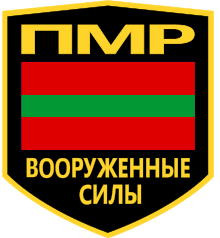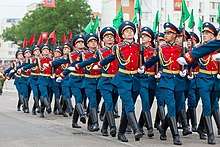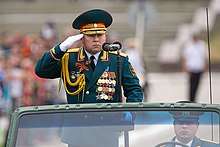Armed Forces of Transnistria
The Armed Forces of the Pridnestrovian Moldavian Republic (Russian: Вооружённые силы Приднестровской Молдавской Республики; Vooruzhyonniye Sily Pridnestrovskoy Moldavskoy Respubliki, Romanian: Форцеле армате але Републичий Молдовенешть Нистрене; Forțele armate ale Republicii Moldovenești Nistreene, Ukrainian: Збройні сили Придністровської Молдавської Республіки; Zbroini syly Prydnistrovśkoi Moldavśkoi Respubliky), are the military forces of the semi-recognised state of Transnistria. The Armed Forces were created on 6 September 1991 to protect the sovereignty and independence of the Pridnestrovian Moldavian Republic, in accordance with Article 11 of the Republic's Constitution.[2]
.jpg)
| Armed Forces of the Pridnestrovian Moldavian Republic | |
|---|---|
 Insignia of the Armed Forces | |
| Founded | 6 September 1991 |
| Service branches |
|
| Headquarters | Tiraspol |
| Leadership | |
| Commander-in-chief | |
| Minister of Defence | |
| Chief of the General Staff | |
| Manpower | |
| Military age | 18 |
| Active personnel | 5,500 |
| Reserve personnel | 20,000[1] |
| Industry | |
| Domestic suppliers | |
| Foreign suppliers | |
| Related articles | |
| History | Transnistria War |
In order of precedence, the current military leadership is composed of the following:
- President of Transnistria/Commander-in-Chief – President of Transnistria Vadim Krasnoselsky
- Minister of Defence – Major General Oleg Obruchkov
- Chief of the General Staff – Colonel Sergey Gerasyutenko
History
On 6 September 1991, the Supreme Soviet of Transnistria adopted a resolution which called for the formation of a Transnistrian military unit. As a result, the Republican Guard (Russian: Республиканская гвардия ПМР) was formed. It was the direct counterpart to the Republic of Moldova's Republican Guard (Romanian: Garda Republicană).[3] Both were the predecessors to their respective countries armed forces. In its first major conflict, the guard repelled troops of the Moldovan National Army against the city Dubasari in December 1991. By the end of 1991, the organizational formation of the Transnistrian armed forces was generally completed. Shortly after the outbreak of Transnistrian War in March 1992, the People's Militia was created, having been supported and armed by the Russian Armed Forces 14th Guards Army. By the end of 1992, all main structures of the Ministry of Defense and the General Staff were formed, including individual military units, government agencies, and specialized services. On 14 March 1993, personnel of the new armed forces took the military oath of allegiance to the country.[4]
Units
The armed forces are composed of 4,500 to 5,500 active duty soldiers, (with 15,000 - 20,000 personnel in the reserve).[1][5]
Army Headquarters (Tiraspol)


- General Staff of the Armed Forces – It is the commanding and managing body of the armed forces. It is tasked with enforcing military strategy which comes from the ministry of defense.
- PMR Honour Guard – Since its establishment on 6 November 1997, the PMR Honour Guard has taken part in the welcoming of honoured guests and festive and ceremonies. Notable commanders of the unit include Yaroslav Isak, Valentin Rasputin and Artem Chernichenko.[6][7][8]
- General Staff Band – The band's musicians have at least a year of experience in the musical services of the Russian, Moldovan, and Ukrainian armed forces. Their repertoire includes over 500 works by foreign composers. The band is led by Colonel Vitaly Voinov.[9]
- Special Forces Battalion
- Security Battalion
- Intelligence Company
Regular Army
- 1st Motorised Infantry Brigade (Tiraspol)
- 2nd Motorised Infantry Brigade (Bender)
- 3rd Motorised Infantry Brigade (Rîbniţa)
- 4th Motorised Infantry Brigade (Dubăsari)
- Tank Battalion
- Artillery Regiment
- Anti-aircraft Regiment
- Peacekeeping Force
- PMR Border Guard
Additional support is provided by the Operational Group of Russian Forces of the Russian Army, based in the Transnistrian city of Cobasna.
Military education

- Military Institute of the Ministry of Defense (Военный институт Министерства обороны) – Founded in May 1993, it is the seniormost military institution in the armed forces. It was reorganized as an independent institution from the Shevchenko Transnistria State University on 30 April 2008. In August 2009, the institute was awarded a battle flag and was given the honor of being renamed to honor Alexander Lebed in July 2012.[10]
- Tiraspol Suvorov Military School – It was founded on 1 September 2017 and is based on the Suvorov Military Schools in Russia and Belarus.
- Dzerzhinsky Republican Cadet Corps
- Basic training courses for military specialists
Equipment
Small arms

Armor
.jpg)
| Name | Origin | Type | In service | Notes | ||
|---|---|---|---|---|---|---|
| Armored fighting vehicle | ||||||
| T-64BV | Soviet Union | Main battle tank | 18[11] | |||
| T-55 | Soviet Union | Main battle tank | ||||
| BMP-1 | Russia | Infantry fighting vehicle | ||||
| MT-LB | Russia | APC | ||||
| GMZ-3 | Russia | APC | ||||
| BTR-70 | Soviet Union | APC | ||||
| BTR-60 | Soviet Union | APC | Amphibious capable vehicle | |||
| BRDM-2 | Soviet Union | APC | Amphibious capable vehicle | |||
| Artillery | ||||||
| BM-21 Grad | Soviet Union | Multiple rocket launcher | ||||
| D-44 | Soviet Union | Field gun | ||||
| ZU-23-2 | Soviet Union | Anti-aircraft | ||||
| ZPU-4 | Soviet Union | Anti-aircraft | ||||
| KS-19 | Soviet Union | Anti-aircraft | ||||
| AZP S-60 | Soviet Union | Anti-aircraft | Self-propelled | |||
| 9K38 Igla | Soviet Union | MANPADS | ||||
Air Force

| Aircraft | Origin | Type | Variant | In service | Notes | |
|---|---|---|---|---|---|---|
| Transport | ||||||
| Antonov An-2 | Soviet Union | transport | 3[12] | One has damaged wings and is not airworthy. | ||
| Antonov An-26 | Soviet Union | transport | 1[13][14] | Not airworthy. | ||
| Helicopters | ||||||
| Mil Mi-2 | Soviet Union Poland |
utility / transport | 4[13][15][16] | |||
| Mil Mi-8 | Soviet Union | utility / transport | 6[13][14][16] | One is missing rotor-blades and is not airworthy. | ||
| Trainer Aircraft | ||||||
| Yakovlev Yak-52 | Soviet Union | trainer | 2[13] | |||
Gallery
 Minister of Defense Oleg Obruchkov
Minister of Defense Oleg Obruchkov Pridnestrovian Army personnel (2007)
Pridnestrovian Army personnel (2007) PMR Special Motorized Unit during a parade (2016)
PMR Special Motorized Unit during a parade (2016) The PMR Border Guard
The PMR Border Guard.jpg) T-64BV during a military parade (2010)
T-64BV during a military parade (2010).jpg) The guard of honor of the Tiraspol Suvorov Military School
The guard of honor of the Tiraspol Suvorov Military School- Pridnestrovian Airborne Troops
 Pridnestrovian special forces
Pridnestrovian special forces A Transnistrian Air Force An-2
A Transnistrian Air Force An-2 A Transnistrian Yak-52
A Transnistrian Yak-52
References
- Pridnestrovie.net, Law enforcement and armed forces of Pridnestrovie
- Ministry of Foreign Affairs – Constitution, 2015-09-17.
- http://lex.justice.md/index.php?action=view&view=doc&lang=1&id=306526
- https://inforesist.org/den-vooruzhennyih-sil-nepriznannoy-pmr/amp/
- km.ru, Приднестровье показало мускулы, 2007-09-07 (in Russian)
- http://mopmr.gospmr.org/index.php/1731-rote-pochetnogo-karaula-19-let
- https://novostipmr.com/ru/news/17-11-06/rote-pochetnogo-karaula-pmr-20-let
- http://www.mopmr.idknet.com/index.php/2588-rota-pochetnogo-karaula-otmetila-20-letie
- "Оркестр ГШ ВС ПМР". dvorec-pmr.info. Retrieved 2017-12-22.
- "Выпускники Военного института Министерства обороны ПМР получили дипломы". vestipmr.info. 2015-07-15. Archived from the original on 2017-02-24. Retrieved 2019-05-11.
- "Law enforcement and armed forces of Pridnestrovie | Pridnestrovie.net - Tiraspol, PMR: Pridnestrovskaia Moldavskaia Respublica (Transnistria)". 2009-11-04. Archived from the original on 2009-11-04. Retrieved 2019-06-23.
- "Tiraspol Airport Area 1". Retrieved 2019-06-24.
- "Transnistrian military aviation OrBat". Archived from the original on 2017-10-17. Retrieved 2010-09-30.
- "Photos of Transnistrian military aircraft". 2013-01-10. Retrieved 2013-01-10.
- "Tiraspol Airport Area 1". Retrieved 2019-06-24.
- "Photos of Transnistrian military aircraft". 2013-01-10. Retrieved 2013-01-10.
External links
- Prednestrovie.net, Law enforcement and armed forces of Pridnestrovie (archived link)